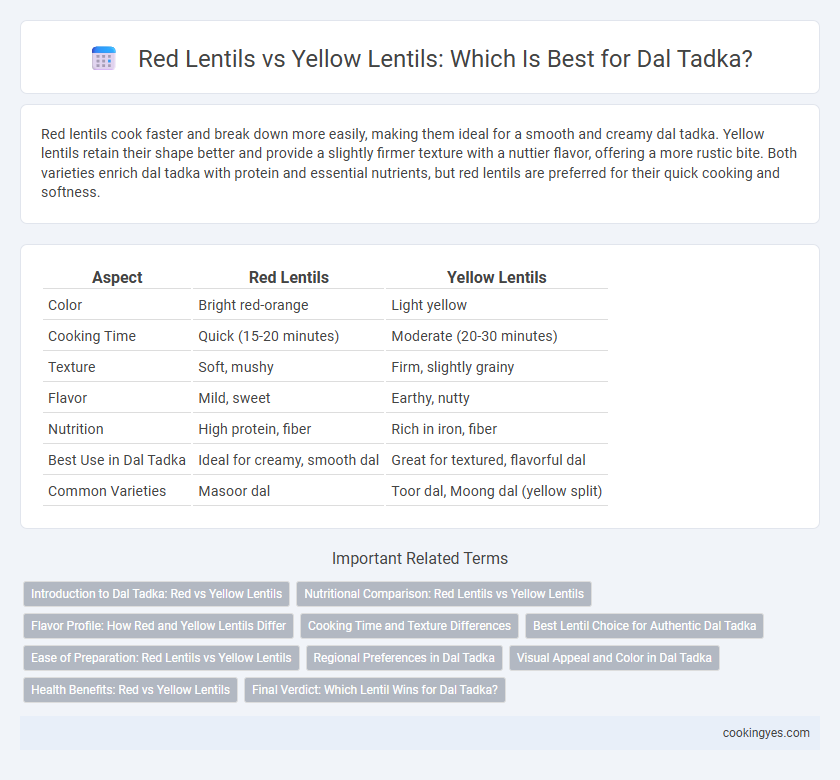Red lentils cook faster and break down more easily, making them ideal for a smooth and creamy dal tadka. Yellow lentils retain their shape better and provide a slightly firmer texture with a nuttier flavor, offering a more rustic bite. Both varieties enrich dal tadka with protein and essential nutrients, but red lentils are preferred for their quick cooking and softness.
Table of Comparison
| Aspect | Red Lentils | Yellow Lentils |
|---|---|---|
| Color | Bright red-orange | Light yellow |
| Cooking Time | Quick (15-20 minutes) | Moderate (20-30 minutes) |
| Texture | Soft, mushy | Firm, slightly grainy |
| Flavor | Mild, sweet | Earthy, nutty |
| Nutrition | High protein, fiber | Rich in iron, fiber |
| Best Use in Dal Tadka | Ideal for creamy, smooth dal | Great for textured, flavorful dal |
| Common Varieties | Masoor dal | Toor dal, Moong dal (yellow split) |
Introduction to Dal Tadka: Red vs Yellow Lentils
Red lentils and yellow lentils serve as the primary pulses in Dal Tadka, each offering distinct textures and flavors. Red lentils tend to cook faster, breaking down into a creamy consistency, while yellow lentils maintain a slightly firmer texture, enhancing the dish's bite. Both lentils are rich in protein, fiber, and essential nutrients, making them ideal for a nutritious and flavorful dal tadka.
Nutritional Comparison: Red Lentils vs Yellow Lentils
Red lentils and yellow lentils both offer rich sources of protein, fiber, and essential minerals, making them ideal for dal tadka. Red lentils have slightly higher protein content at approximately 9 grams per 100 grams, while yellow lentils provide more iron, about 3.3 mg per 100 grams. Both varieties are low in fat and packed with B vitamins, supporting overall heart health and digestion.
Flavor Profile: How Red and Yellow Lentils Differ
Red lentils have a mild, slightly sweet flavor that becomes creamy and smooth when cooked, enhancing the richness of dal tadka without overpowering the dish. Yellow lentils offer a nuttier, earthier taste with a firmer texture, providing a hearty base that holds up well to tempering spices. Choosing between red and yellow lentils impacts the overall flavor complexity and mouthfeel, making the selection crucial for the desired dal tadka experience.
Cooking Time and Texture Differences
Red lentils cook faster than yellow lentils, typically softening within 15-20 minutes, making them ideal for quick dal tadka preparations. Yellow lentils require a longer cooking time, around 30-40 minutes, resulting in a firmer texture that holds shape better in the dish. The softer, mushier consistency of red lentils creates a creamier dal, while yellow lentils provide a slightly grainier texture, enhancing the overall mouthfeel.
Best Lentil Choice for Authentic Dal Tadka
Red lentils are the best lentil choice for authentic dal tadka due to their quick cooking time and smooth texture, which creates the perfect creamy base. Yellow lentils, while also used, tend to have a firmer texture and slightly earthier flavor that can alter the traditional taste profile. Red lentils' ability to break down easily allows the tadka spices to infuse thoroughly, enhancing the dish's signature flavor and authenticity.
Ease of Preparation: Red Lentils vs Yellow Lentils
Red lentils cook faster than yellow lentils, typically softening within 15-20 minutes, making them ideal for quick dal tadka preparations. Yellow lentils require longer cooking times, often around 30-40 minutes, but they hold their shape better, offering a firmer texture. For ease of preparation and time efficiency, red lentils are preferred in traditional dal tadka recipes.
Regional Preferences in Dal Tadka
Red lentils (Masoor dal) are widely preferred in North Indian dal tadka for their quick cooking time and soft texture, making them ideal for creamy, spiced gravies. Yellow lentils (Moong dal or Toor dal) dominate in South Indian and Western regions due to their mild flavor and slightly firmer texture, which hold up well in tempering with mustard seeds, curry leaves, and dry red chilies. Regional preferences in dal tadka often hinge on the balance between cooking speed, texture, and the complementing spices typical to each cuisine's culinary traditions.
Visual Appeal and Color in Dal Tadka
Red lentils (masoor dal) create a vibrant orange hue in dal tadka, enhancing its visual appeal with a warm and inviting color. Yellow lentils (toor dal) produce a golden-yellow tone, offering a rich, traditional look that complements the spices and tempering. The choice between red and yellow lentils significantly influences the dish's aesthetic, with red lentils providing a brighter, more eye-catching appearance.
Health Benefits: Red vs Yellow Lentils
Red lentils and yellow lentils both provide essential nutrients such as protein, dietary fiber, and iron, making them excellent choices for dal tadka. Red lentils cook faster and have a softer texture, which aids digestion and enhances nutrient absorption, while yellow lentils contain slightly higher levels of folate and vitamin B complex, supporting energy metabolism and cardiovascular health. Incorporating either lentil into dal tadka promotes heart health, stabilizes blood sugar, and improves gut health through their rich antioxidant and anti-inflammatory properties.
Final Verdict: Which Lentil Wins for Dal Tadka?
Red lentils (masoor dal) offer a softer texture and quicker cooking time, making them ideal for a smooth dal tadka, while yellow lentils (moong dal) provide a mildly sweet flavor and firmer consistency that holds well during tempering. Nutritionally, red lentils have higher iron content, whereas yellow lentils are rich in potassium and fiber, enhancing digestion and heart health. For a balanced dal tadka with optimal taste and nutrition, yellow lentils slightly edge out red lentils, but personal preference for texture remains key.
Red lentils vs Yellow lentils for dal tadka Infographic

 cookingyes.com
cookingyes.com